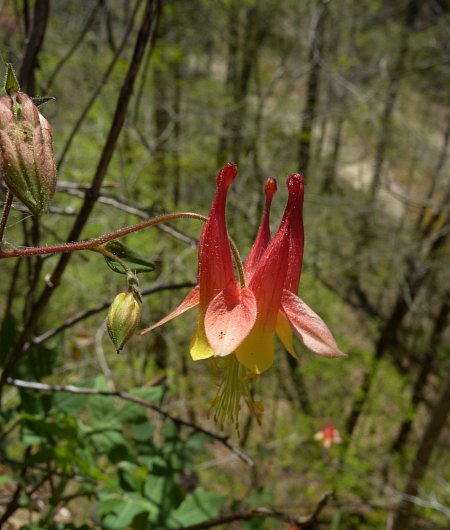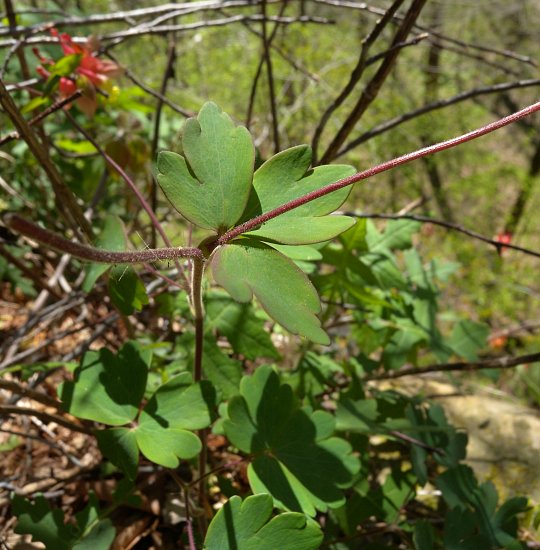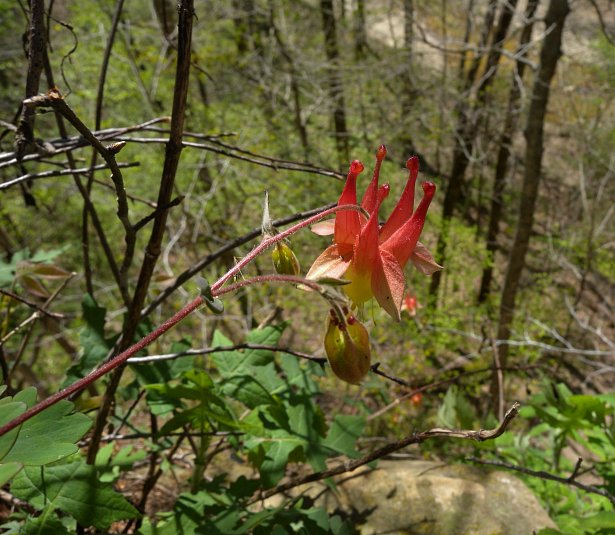Description: This herbaceous perennial plant is 1-3' tall and sparingly branched. The round stems are green to reddish green and glabrous or pubescent. At first, only basal leaves are produced, but later there are alternate leaves along the stems. These leaves are ternately compound (divided into groups of 3 leaflets) and they have long petioles that are glabrous or pubescent. Each leaflet is up to 3" long and 2" across; it is usually obovate in shape with a wedge-shaped bottom, but it divides into 3 rounded lobes. Each of these lobes is often subdivided into several secondary lobes, resembling large rounded teeth. The upper surface of each leaflet is glabrous and there may be areas with a whitish bloom. The leaflets can be sessile or stalked. The upper stems produce flowers individually or in groups of 2-3.

Each flower is
about 1½" long and it hangs downward from a long stalk. This flower has
5 petals, 5 petal-like sepals, and strongly exerted stamens and styles.
Each petal is yellow and rounded toward the tip, but its base consists
of a long nectar spur that is pale red to purplish red. The sepals are
ovate in shape and they are the same color as the nectar spurs. The
nectar spurs of mature flowers are erect (parallel to each other) or
slightly spreading. The anthers of the stamens are bright yellow. The
blooming period occurs from late spring to early summer and lasts about
a month. There is no floral scent. Each flower is replaced by 5
pod-shaped follicles that have long beaks. Each follicle splits open
along one side to release the shiny black seeds. The root system is
fibrous and rhizomes are occasionally produced.
Cultivation:
The preference is light shade to partial sun, moist to dry conditions,
and soil that is loamy, rocky, or slightly sandy. Mature plants can
also tolerate full sun, although young plants require some shade from
neighboring vegetation. Once it becomes established, this plant is easy
to maintain.

Range &
Habitat:
The native Wild Columbine occurs occasionally in most areas of
Illinois, although
it is uncommon or absent in south-central Illinois (see Distribution
Map). Habitats include rocky open woodlands, wooded slopes,
sandy savannas, thinly wooded bluffs, partially shaded areas of cliffs,
limestone glades, fens and bogs, openings in logged woodlands, and
areas along railroad tracks. Occasional wildfires and other kinds of
disturbance in wooded areas are probably beneficial in maintaining
populations of this plant.
Faunal Associations:
Bumblebees and the Ruby-Throated Hummingbird visit the flowers for
nectar; bumblebees may also collect pollen for their larvae.
Short-tongued Halictid bees collect pollen from the flowers, but they
are less effective at cross-pollination. The larvae of various insects
feed on Wild Columbine, including those of Erynnis lucilius
(Columbine Duskywing), Papaipema leucostigma (Borer
Moth sp.), Pristophora aquiligae (Columbine
Sawfly), and several Phytomyza spp. (Leaf Miner
Flies). Because the foliage is toxic, it is little bothered by
mammalian herbivores.

Photographic
Location:
Along a cliff at the Shady Rest Nature Preserve in Piatt County,
Illinois.
Comments:
This is the only Aquilegia sp. (Columbine) that is
native to Illinois. Other species in this genus occur in the Western
states. The flowers of Wild Columbine are colorful and attractive, and
the foliage is attractive as well. The cultivated Columbines that are
sold by nurseries usually have Aquilegia vulgaris
(European Columbine) as one or both of the parents. European Columbine
rarely escapes from cultivation. It can be distinguished from Wild
Columbine by spreading nectar spurs and weakly exerted stamens. While
the flowers of Wild Columbine are always some shade of red, the flowers
of cultivated Columbines are often other colors, including pink and
blue.